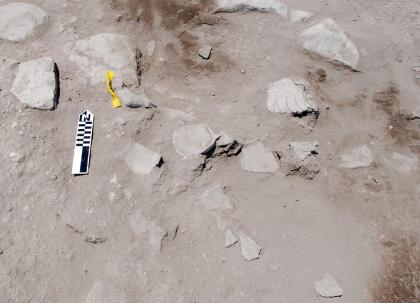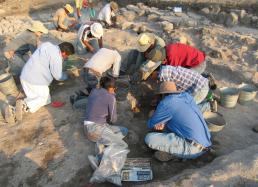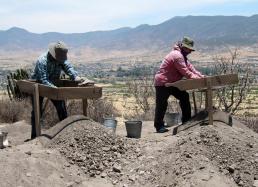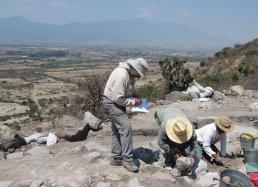7: Zapotec Urns and Their Demise (Chapter Two)
In 2010, my sixth dispatch from Mitla was entitled, “The Iconic Zapotec Urn and Its Disappearance.” Due to the relevance of one of our findings this past week, I have taken the unusual step of reprising a large part of last season’s message below. For those who remember that text, I apologize, however, that dispatch does provide a fitting context for this week’s odd, but parallel discovery. I still have few answers, but we do have yet another well-documented instance of a now recurring phenomena. After the edited and shortened message from 2010, I'll fill you in on the latest chapter.
May 31, 2010: Whether you peruse museum exhibitions or textbooks, there is no more iconic artifact associated with the Valley of Oaxaca Classic period (ca. A.D. 250-900) than the Zapotec urn. These fired clay vessels, amply illustrated a half century ago in a masterful compendium, Urnas de Oaxaca, by Alfonso Caso and Ignacio Bernal (1952), generally feature Cocijo (a Zapotec supernatural force associated with lightning), individuals wearing a mask of Cocijo, or other supernatural forces or entities associated with rain and fertility (See the Burial Practices Photo Gallery example of an urn depicting Pitao Cozobi, another Zapotec supernatural.)
The Zapotec began making ceramic urns not long after Monte Albán was founded (ca. 500 B.C.), but these urns became much more numerous during the Classic period. Early in that period, urns, which generally have two components (a vase-like container fronted by a figural representation), were usually modeled by hand and formed of one piece.
Yet by the latter half of the Classic period, these urns became more symbolically detailed and incorporated a far greater number of molded and prefabricated pieces (such as molded earspools, feather representations, and modeled arms) into the final artifact. The appliqué pieces were molded or modeled, dried to a leather-hard state, and then affixed to the front of the vase (in a carefully planned sequence) with wet clay. These repeating elements give the later urns an iconic and standardized feel, although the specific combination of elements is rarely, if ever, entirely the same.
For all the Zapotec urns present in museum collections around the world and depicted in books, comparatively few complete urns have been found in situ (in place, with precisely documented archaeological contexts). The complete or nearly complete urns found in situ generally have been recovered by archaeologists either inside or in front of tombs, with other less formal burials, or as part of offerings or altars (both latter contexts without accompanying human remains).
Not surprisingly, when excavating Classic-period settlements in the Valley of Oaxaca (and Linda and I have now had the chance to investigate at three), it's much more common to recover small, broken urn fragments than more complete urns. The same is the case for ceramic bowls, jars, and every other pottery form. Eating and cooking vessels are regularly moved and placed both over and near fires, and so finding a ratio of many broken pieces for each whole pot is entirely understandable. But why so many broken urn fragments?
Perhaps, it could partly have a bit to do with the way they were assembled. Clay pieces are prepared but never attached. Other pieces likely were not affixed well, and so they broke off. In still other situations, offerings or human interments clearly were disturbed by later episodes of construction in the same residence or location, potentially leading to broken vessels and a scattering of bones. But I’m not sure if all of the aforementioned scenarios are enough to explain the ratio of recovered urn parts relative to the sparsity of complete urns.
It would appear that urns may also have been broken ritually, although whether such activities occurred in association with calendar cycles and/or other events is not clear. Nevertheless, if the Zapotecs intentionally broke some of their urns, they generally seem to have taken pains to disperse the ruptured pieces, for it’s extremely rare to find numerous parts of a single urn together in the ground, except when they're still in their original (primary) depositional contexts. In other words, if the urns broke through the acts of later construction or more recent farming, you might expect to find many pieces of the same urn still close together, but that rarely happens.
Another question that we continue to ponder regarding urns is why did the Zapotecs stop making this iconic artifact? What seems clear is that late in the Classic period, perhaps during the 8th or 9th centuries A.D., these urns, so symbolically rich and widely found in the Valley of Oaxaca, were no longer made, or at least they became much rarer.
Some researchers might suppose that the decline of the iconic urns might relate to a population replacement of the valley Zapotecs by Mixtecs (who did not make such pieces nor revere Cocijo) at the end of the Classic period. But as I have commented before, the notion of a full-bore Mixtec invasion or population replacement in the valley does not have much empirical support. And the best evidences for a Mixtec elite presence (likely through elite intermarriages with Zapotecs) and accompanying cultural influences date to centuries after the decline of Zapotec urns.
Rather, the decline in urns would appear to owe more to shifts in Zapotec society and cultural practice toward the end of the Classic period rather than to a cultural or ethnic replacement. With the Late Classic-period decline of Monte Albán and the rise of local rulers at a dozen or more outlying valley centers, the rituals associated with power, rule, and political legitimacy appear to have shifted, perhaps spelling a lessening role for long-held rituals in which powerful individuals portrayed Cocijo or other supernaturals (as often depicted in the urns).
Perhaps, legitimacy was now gained more readily through lineal links to specific powerful forebears as depicted in Late Classic genealogical registers (discussed and illustrated in my 2008 Dispatches concerning El Palmillo) that illustrate sequences of ruling pairs, each specific to a single settlement or center. The above speculation remains no more than a viable hypothesis at present. Yet two sets of findings (one from 2008 at El Palmillo and the other from this season at the Mitla Fortress) that both date to late in the Classic period provide some tantalizing perspectives on ritual behavior during the last years of the Zapotec urn.
In 2008 at El Palmillo, when excavating an elaborate palace (Platform 11) near the apex of the site, we were surprised during the excavation of the fill that separated the penultimate and ultimate levels of the main patio of this structure. In the fill, which otherwise was relatively clean of artifacts, we found many urn fragments (all heavily burnt and some large pieces) from a number of tall urns. The fill also included a few scattered human bones. The urns and the bone clearly were intentionally added to the fill above the earlier patio, as there were no signs that more typical trash was mixed in.
When we got back to the lab, after that year’s excavations, we made a series of interesting observations. While we didn't have all or even most of the pieces from any one urn, the nine large and elaborate earspool pieces that we unearthed indicated that we likely had parts of at least five similar urns (figuring two earspools per urn). Significantly, none of those parts of the urn that were associated with a principal figural representation, such as Cocijo, were present in the palace patio fill or anywhere else in our excavation area. So those pieces evidently were deposited elsewhere, separate from the pieces we found.
A tenth earspool of the same type also was discovered in the fill of a pit that had been dug down to an earlier tomb, which had been used during the penultimate occupation of this palace. When we excavated down to this tomb, it was evident that it had been disturbed by those who dug the pit, immediately prior to the transition to the last occupational surface.
What appears to have happened is that when the Platform 11 palace was remodeled for the last time, the occupants reopened the cut in the patio floor that led down to their tomb. They raised five urns and much of the bones from the tomb. The urns were broken and heavily charred with select broken pieces (along with some bone) and deposited in the earthen fill that sustained the final patio.
The last palace occupation did not have a tomb, and few urn fragments were found in association with the final habitation of the residence. Although the recovery of urn fragments is not in itself unusual, the purposeful retrieval of these urns to break them, burn them, and then deposit so many of the pieces, including large pieces, together in a single context is not something we have seen elsewhere.
These El Palmillo findings were amplified by a discovery that we made at the Mitla Fortress in 2010. As at El Palmillo, the finding pertains to an episode of remodeling (on Terrace 57) that dates to later in the Classic period. The complex that we excavated on Terrace 57 turned out to be more elaborate than we initially expected, especially during its earlier building episode, although it's no where near as large or elaborate as Platform 11 at El Palmillo.
Our finding pertained to the transition from this earlier occupational episode to the subsequent one, a transition that we date to roughly the same time (or perhaps just slightly earlier) as the aforementioned remodeling of Platform 11. During its earliest building episode, the room-patio complex on Terrace 57 was composed of a series of rooms around a central patio. The north room in this group had an altar or shrine at the front (facing the patio) of the room. When this complex was remodeled, the nature of this room changed, so that the altar was built over and an adobe wall separated the room from the patio.
As we scraped this room’s plaster floor, we noted that when the altar was covered, a Zapotec urn that likely sat on the altar was buried under the floor as an offering. What made this urn intriguing was that only the lower half of the vessel was buried, having been broken from the top of the urn, which must have been deposited elsewhere. As with the burnt El Palmillo urn fragments, the missing urn parts included the featured individual’s face. To add to the mystery, a chert projectile point was stuck inside the vase cavity of this vessel where the head might have been expected (See urn photo).
The scientific jury remains out regarding whether these two findings of purposeful urn destruction in the Late Classic period can help decipher what happened to the iconic Oaxacan vessels and why they stopped being made. Nevertheless, the intentional breaking of these vessels and then using them in offerings (but without their most representational parts) does seem to reflect a possible shift in the ways that urns were ritually used and curated over time. Perhaps, over time and with more research, we'll gain greater insights into the demise of the Zapotec urn and how it may have been linked to other shifts in the lifeways and organization of the prehispanic Valley of Oaxaca.
Well, we now (in 2011) have a third case, also from late in the Classic period, to add to the two above. As on 2010’s Terrace 57, this year’s residential complex (Terrace 276) was rebuilt a number of times. As we proceeded to excavate down from one level of the patio to the one below, we encountered a sizeable number of urn fragments that were intentionally broken and scattered (see above photo.) The fragments sat above the older patio surface on a bed of hard-packed earth or adobe.
Once again, these pieces appear to come mostly from a single urn (and a large one at that), which perhaps stood originally at roughly a half-meter (based on the parts found). But, as in the two earlier instances, only a portion of the full urn is represented and the pieces present do not include any facial depictions of the urn’s central figure. Rather, the scattered urn fragments include one of the figure’s arms, many feather representations, and major fragments from the vase (see Photo #1 below.)
Perhaps, the central question remains: was this intentional and likely ritualized destruction of the urns something that mostly occurred late in the Classic period, around the time when the urns ceased being made in this iconic way? Or, was the ritual dismantling of urns something that happened throughout the object’s history of use? To determine the answer, we would need to know if urns were ritually destroyed earlier in the Classic period as well as at the end of that era. Yet, at the same time, the more cases of such patterned urn destruction that we have for late in the Classic period, the stronger our hypothesis becomes that such actions may have been indicative of a change in long-held beliefs or traditions.
More soon,
Gary






